Are you ready to take your first steps in Irish dance? Whether you’re a complete novice or have some experience in dancing, this ultimate beginner guide will cover everything you need to know about this iconic dance style.
From the history and cultural significance of Irish dance to the basic techniques and steps, you’ll be well on your way to mastering the lively rhythms and intricate footwork that define this beloved art form.
But before we dive into the details, let’s explore why Irish dance is such an exciting and rewarding pursuit.
It is a great way to stay active and improve your fitness level and offers a unique opportunity to connect with rich cultural traditions while expressing yourself through movement.
So whether you’re looking for a new hobby or hoping to compete at the highest levels, read on to discover all there is to know about Irish dance.
Table of Contents
Toggle
History of Irish Dance
The origins of Irish dance and its evolution are fascinating to explore. The earliest roots of Irish dance can be traced back to pre-Christian times when it was used as a form of storytelling and celebration. As Christianity spread throughout Ireland, the pagan rituals associated with dance were replaced by new religious traditions, but the love for dance remained.
During the 18th century, Irish step dancing began to take shape as we know it today. This style of dancing involves quick footwork and intricate leg movements, with dancers keeping their upper bodies still.
Over time, different styles emerged, such as Sean-nós (old style) dancing, which features a looser and more relaxed approach than traditional Irish step dancing. Other famous Irish dances include ceili (social) dancing and set dancing. Set dances can be performed either individually or in groups.
Understanding the history of Irish dance is an important foundation for any beginner looking to master this art form.
Types of Irish Dance
Irish dance is a vibrant and diverse art form with a rich cultural history. As you delve into the world of Irish dance, it’s essential to understand the various styles and their unique characteristics. Here, we break down the different types of Irish dance, focusing on hard-shoe and soft-shoe dances and the differences between ceili and set dances.
Different Types of Irish Dance
There are many different types of Irish dances. Each type of dance has its own unique flair and rhythm.
Hard shoe dances are characterized by strong percussive movements emphasizing rhythm and timing. Hard shoe dancing has roots in traditional Irish step dancing, which was once performed in everyday footwear. The first hard shoe was made from leather with wooden heels and tips but has evolved over the years to include fiberglass or plastic.
Some popular hard shoe dances include:
- The Hornpipe: A lively dance with a syncopated rhythm, often performed in a 4/4 time signature.
- The Treble Reel: A fast-paced dance with intricate footwork and a focus on the dancer’s ability to create clear, sharp sounds with their shoes.
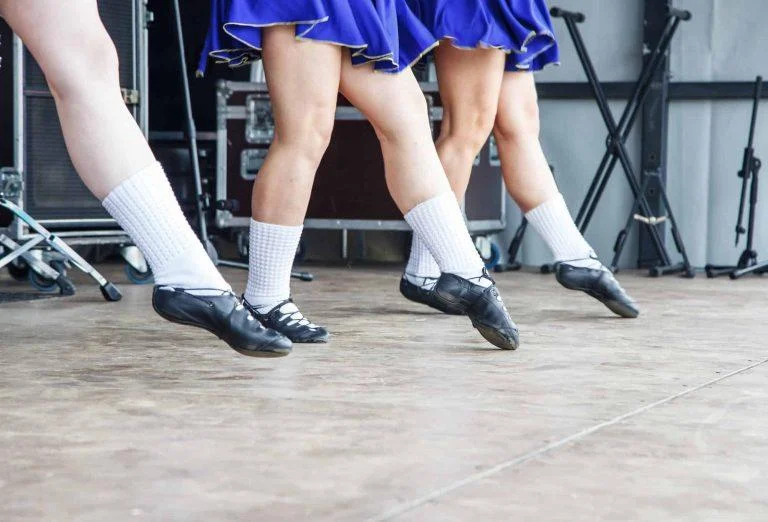
In contrast, soft shoe dances emphasize graceful footwork, where dancers wear flexible leather shoes that allow for more fluid movement. These dances originated from social settings such as weddings and other celebrations where people would gather to dance in their best attire. Soft shoe dancing is also performed as Ceili dancing, focusing on group choreography rather than individual performance.
Some popular soft shoe dances include:
- The Reel: A lively and energetic dance performed in a 4/4 time signature, focusing on smooth footwork and precise timing.
- The Slip Jig: A graceful dance with a 9/8 time signature, often called the “ballet of Irish dance” due to its elegant movements and light, airy feel.
Whether you prefer hard or soft shoe dancing, both styles showcase the history of Irish dance while allowing individuals to express themselves through intricate footwork and rhythmic beats.
Difference Between Celli And Set Dances
How do Ceili and Set dances differ? Both are traditional forms of Irish social dancing.
But, there are some distinct differences between the two.
Ceili dances are group dances performed by four or more couples in a set formation. The dancers move in unison to music played by live musicians, creating intricate patterns and formations on the dance floor.
On the other hand, Set dances are performed by only two or three couples with specific steps and movements unique to each set. In addition, the music for set dances is also typically fast-paced, requiring greater skill and precision from the dancers.
While both types of Irish dance offer numerous benefits, such as increased cardiovascular fitness and improved coordination, it’s important to understand their differences before diving into either.
Basics of Irish Dance
Let’s talk about the basic moves and positions of Irish dance.
First, there’s the ‘reel,’ which involves quick and light movements of the feet and ankles.
For posture and footwork, it’s important to keep your back straight, chin up, and focus on landing softly on the balls of your feet.
Basic Moves and Positions of Irish Dance
In Irish dance, dancers use their entire body to execute precise footwork while maintaining a straight posture and keeping their arms at their sides.
The most basic move in Irish dance is the ‘Over 2-3′, which involves hopping onto one foot, bringing the other foot up behind it, and then stepping onto that back foot. This step can be done in various directions, such as forward or sideways.
Another important move, commonly known as a ‘shuffle’ or a ‘treble,’ is a popular movement in heavy shoes which involves quickly alternating the feet while creating rhythms.
Irish dance also features several positions essential for executing more advanced moves. One is the ‘first position,’ where the heels are together, and the toes are turned outward.
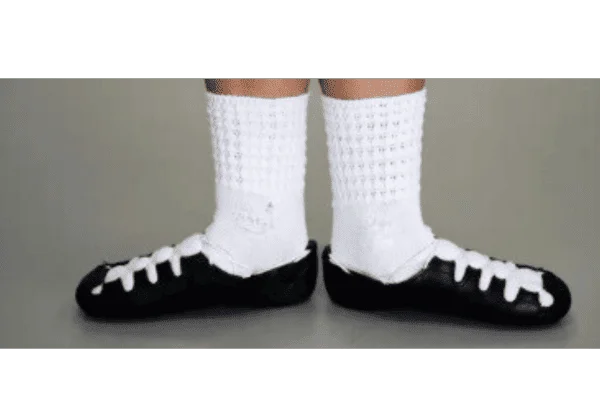
Another common position is the ‘fifth position,’ where one heel is placed in front of the other with both toes pointing outward. These positions may seem simple but require practice to ensure proper form and execution in more complex dances.
You’ll be on your way to becoming an accomplished Irish dancer by mastering these basic moves and positions.
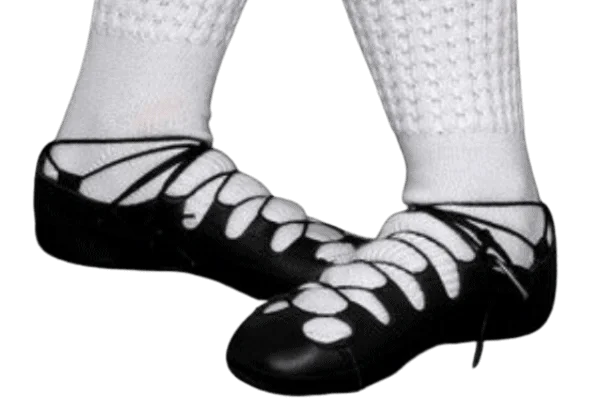
Tips For Proper Posture And Footwork
Maintaining good posture and footwork is essential to Irish dance, as it not only enhances the visual appeal of your performance but also helps prevent injuries.
To achieve proper posture, stand tall with your shoulders back, chin up, and core engaged. Keep your arms relaxed by your sides, your elbows slightly bent, and your hands in a loose fist. Always look straight ahead and avoid tilting your head or hunching over.
Footwork is another crucial aspect of Irish dance that requires precision and coordination. Start practicing basic steps such as the reel or jig with slow and deliberate movements to ensure accuracy.
When performing more complex steps, keep your feet close to the ground while maintaining a light bounce in each step. Remember to keep your weight evenly distributed between both feet and avoid leaning forward or backward.
With practice and dedication, you can master proper posture and footwork in Irish dance for an awe-inspiring performance.
How to Get Started with Irish Dance
Finding a reputable Irish dance instructor is crucial to your success as a beginner. You want someone experienced, knowledgeable, and patient.
Various resources are available to help you find local Irish dance schools, such as online directories, community centers, and word-of-mouth recommendations.
Once you’ve found a class, expect a warm-up, drills for technique, learning choreography, and lots of fun.
Finding A Reputable Instructor
You’ll want to find a trustworthy instructor who can guide you through your journey of learning this exciting and challenging art form.
A reputable instructor will teach you the proper techniques and steps, ensuring you dance safely and avoid injuries. They will also provide valuable feedback on your progress and help motivate you to achieve your goals.
When searching for an Irish dance instructor, look for someone with experience teaching beginners and a strong background in traditional Irish dance.
Be sure to check their credentials and reputation by reading reviews from past students or even asking for recommendations from other dancers in the community.
Ask questions during your initial meeting with them to see if they are a good fit for your learning style and personality.
Finding the right instructor is key to success in any new skill or hobby, so take the time to research before committing to any classes or lessons.
Resources For Finding Local Irish Dance Schools
If you’re on the hunt for local Irish dance schools, plenty of online resources can help you navigate the options.
Here are some resources to help you locate Irish dance schools in your area:
- Online Search: Your search should start with “Irish Dance Near Me.” This will give you a list of local Irish dance schools.
- Our Directory Page: We continually add more Irish Dance Schools to our directory page to help you find a local dance school.
- Regional Irish Dance Associations: Many countries and regions have their own Irish dance associations, such as the An Coimisiún Le Rincí Gaelacha for Ireland, the North American Irish Dance Federation for North America, and the Australian Irish Dancing Association for Australia. These associations often provide information on local Irish dance schools.
- Social Media: Facebook, Instagram, and Twitter can be helpful for finding Irish dance schools in your area. Search for local Irish dance groups, pages, or hashtags to discover nearby schools and classes.
- Local Community Centers and Cultural Organizations: Many community centers, cultural organizations, and Irish heritage centers offer Irish dance classes or can provide information about local dance schools.
- Word of Mouth: Asking friends, family, or coworkers interested in Irish dance is another great way to find local dance schools. They may have personal recommendations or know of schools in the area.
By utilizing these resources, you’ll be well on your way to finding the perfect Irish dance school to start your journey in this captivating art form.
What To Expect In A Typical Irish Dance Class
In a typical Irish dance class, you’ll be swept away by the lively music and intricate footwork that make you feel like you’re part of an exhilarating performance.
The class usually begins with warm-up exercises to prepare your muscles for the intense footwork. You’ll then learn the basic steps, usually broken down into smaller parts so beginners can follow along easily.
Once you’ve mastered the basics, your instructor will move on to more complex steps and combinations. These may include jumps, spins, and partner work. Don’t worry if it seems overwhelming at first; with practice and dedication, you’ll soon be able to keep up with the rest of the class.
In addition to mastering the steps themselves, you’ll also need to work on your posture and overall presentation, as these are important aspects of Irish dance performance. So get ready to sweat, have fun, and become a skilled Irish dancer.
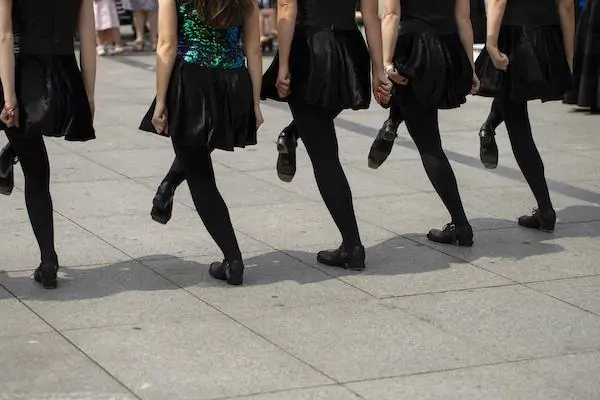
Practice and Training
Practicing at home is an essential part of improving your Irish dance skills. You can start by setting a regular practice schedule that works for you and creating a comfortable space to practice in.
To get the most out of your at-home practices, focus on perfecting the basic steps before moving on to more complicated routines. To progress in Irish dance, taking classes regularly and seeking feedback from teachers or experienced dancers is important.
Also, watch performances and competitions online to see different styles and techniques. Feel free to challenge yourself with new steps or choreography as well. But, you must master the essential basic moves before moving to more advanced steps.
Preparing for performances and competitions requires careful planning and attention to detail. Make sure you have the right shoes, costumes, music, and accessories well in advance. Use your practice time wisely by rehearsing specific routines or sections multiple times until they feel natural.
Remember to focus on your goals and push yourself to perform at your best.
Practicing At Home
You can improve your skills and impress others by practicing at home. The key to successful Irish dance practice is consistency.
Start with setting a regular schedule that works for you, whether it’s 30 minutes every day or an hour twice a week. Then, find a quiet space where you won’t be interrupted and put on some traditional Irish music to get in the mood.
Begin your practice with warm-up exercises, such as stretches and footwork drills, to prepare your body for dancing. Then, perfect basic steps before moving on to more complex routines.
Use mirrors to check your form and posture, paying attention to your arms, feet, and head positioning. Remember to take breaks when needed, but try to maintain focus during practice sessions.
With consistent effort, you’ll see progress in no time.
How To Progress
If you want to improve your skills and take your dancing to the next level, setting goals and developing a plan for progressing is important.
Start by identifying areas where you need improvement—perhaps you need more practice with footwork or better posture during jumps. Once you’ve identified these areas, schedule focused practice time each day.
This might mean practicing for 30 minutes after school or work or scheduling longer blocks on weekends. In addition to setting specific goals for technique and skill development, it’s also important to set broader goals related to performance and competition.
Maybe your goal is to perform in front of an audience within the next six months or compete in a local dance competition within the next year. Whatever your goals, be sure they’re realistic and achievable with consistent effort over time.
By setting clear goals and working towards them consistently, you’ll find yourself making progress faster than ever.
How To Prepare For Performances And Competitions
If you want to be fully prepared for upcoming performances and competitions, it’s important to have a game plan in place well in advance.
This means creating a schedule that includes regular practice sessions, rehearsals with your dance group or partner, and time to perfect your performance routine. In addition, paying attention to your physical fitness by maintaining a healthy diet and getting enough rest is also crucial.
In addition, focus on mental preparation by visualizing yourself performing flawlessly and staying positive throughout the process. Finally, consider recording yourself during practice sessions to review and improve your technique.
Lastly, remember the importance of attire; ensure you have comfortable shoes that fit correctly and appropriate costumes or outfits for each performance.
With these steps in place, you’ll be ready to confidently and easily take on any performance or competition.
Benefits Of Irish Dance
In terms of the physical and mental benefits of Irish dance, you can expect to see improvements in your cardiovascular health, balance, coordination, and overall fitness level.
This dance has been shown to reduce stress and improve cognitive function.
As you continue to learn and practice this Irish dancing, you’ll notice increased confidence and improved social skills through the supportive community surrounding Irish dance.
Physical And Mental Benefits
You’ll feel your body come alive as you move in ways that strengthen your muscles, improve your coordination, and increase your endurance while boosting your mood and reducing stress.
The physical benefits of Irish dance are numerous. As you develop the skills needed to perform intricate footwork and fast-paced movements, you’ll notice improvements in flexibility, balance, and agility. You’ll also build strength in your legs, core, and upper body as you hold positions for extended periods.
But the benefits continue beyond there. Irish dance is not just a physical activity; it’s also a mental workout. As you learn new steps and choreography, you’ll challenge yourself mentally by improving memory retention and increasing focus. Additionally, performing in front of an audience can help boost self-confidence and reduce anxiety.
With all these benefits combined, it’s no wonder Irish dance has become such a popular activity for people looking to improve their physical and mental health.
Build Confidence And Improve Social Skills
You might be surprised to learn that dancing can do more than just benefit your physical and mental health; it can also help you build confidence and improve your social skills.
Irish dance encourages individuality while promoting a sense of community within a team or class. In addition, as dancers progress in their skills, they gain the confidence to perform in front of larger audiences, which can translate into improved public speaking abilities or simply being comfortable in social situations.
Irish dance requires teamwork and communication between dancers. This fosters strong social skills as dancers learn to work together towards a common goal and support each other throughout the learning process.
Whether practicing steps together or performing at competitions, Irish dance creates opportunities for individuals to connect with others who share their passion for dance and music.
Overall, Irish dance is an enjoyable pastime and a great way to develop important life skills such as confidence and social competence.
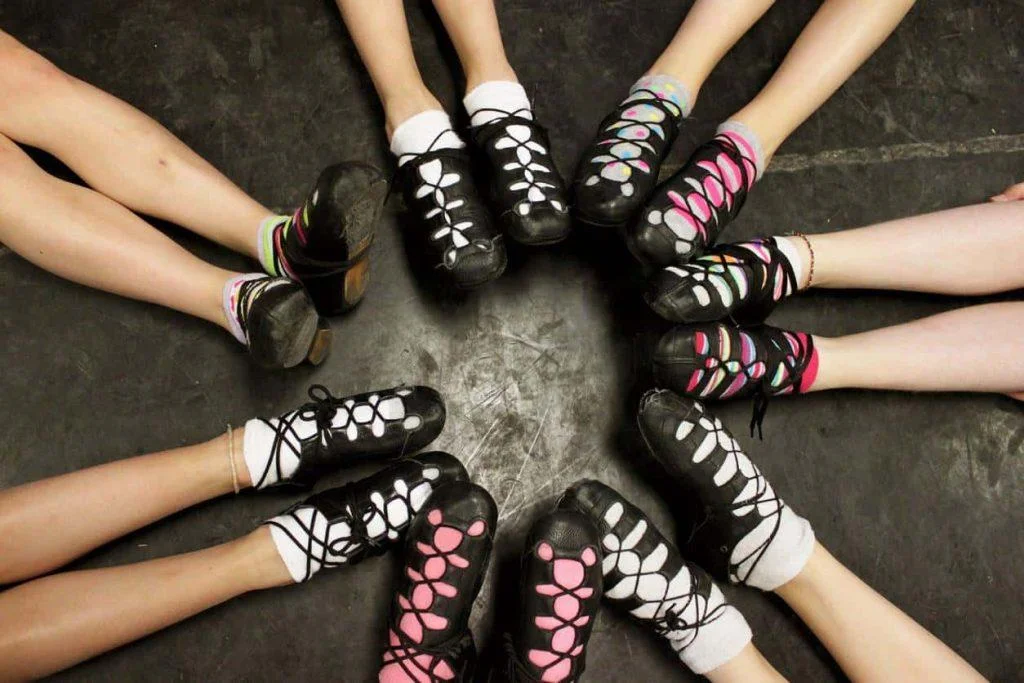
Take Away
Now that you’ve learned more about this beautiful art form, it’s time to take the leap and try it. Who knows, Maybe you’ll find a new passion or make some amazing friends along the way.
Imagine feeling the adrenaline rush as you perform in front of a cheering crowd or experiencing the joy of nailing that complicated footwork sequence after weeks of practice. Irish dance is not only an excellent workout for your body but also for your mind.
It requires discipline, focus, and repetition to master each step. But, by practicing regularly, you’ll improve your memory skills and build self-confidence. So why not join a class today and start your journey toward becoming an Irish dancer?
Many resources are available online to help you find classes near you or learn more about this fascinating art form. Don’t be afraid to ask questions and seek guidance from experienced dancers – they’ll gladly share their knowledge with you.
Frequently Asked Questions
What is the significance of the costumes worn in Irish dance?
When you step onto an Irish dance floor, one of the first things that catches your eye is the stunning costumes worn by dancers. These dresses and outfits are visually striking and hold great significance in the world of Irish dance.
The intricate designs and vibrant colors are meant to represent different regions and styles of Ireland while also showcasing a dancer’s personality and flair. In addition, traditional Irish dance costumes feature hard shoes with unique designs that create a distinct sound when hitting the floor.
As a beginner in Irish dance, understanding the history and meaning behind these costumes can deepen your appreciation for this beautiful art form.
Is Irish dance only for children or can adults participate as well?
You may be surprised to learn that Irish dance isn’t just for children; adults can also participate.
Many adult dancers find the discipline and artistry of Irish dance to be a fulfilling hobby or even a competitive sport.
It’s never too late to start learning the intricate footwork and graceful movements that make up this beautiful form of expression.
Irish dance offers something for everyone, whether you’re looking for a new challenge or simply wanting to connect with your heritage.
So why not give it a try? You might just discover a passion you never knew existed.
How do I find a reputable Irish dance school or teacher?
To find a reputable Irish dance school or teacher, start by asking for recommendations from friends or family who have experience with the dance.
You can also search online for schools in your area and read reviews from former students. Finally, research the credentials of any potential teachers, including their training and performance experience.
It’s important to find a teacher who is skilled and passionate about teaching and creating a positive learning environment. Don’t be afraid to try different schools or teachers until you find the right fit.
Remember that Irish dance is not just for children – plenty of adult dancers are out there, so don’t hesitate to join in on the fun.
Can I participate in Irish dance competitions without joining a school?
You’re eager to compete in Irish dance but don’t want to join a school. The good news is that it’s possible to participate in competitions without being part of a school.
However, it’s important to note that Irish dance competitions are highly regulated and organized by governing bodies. You’ll need to register independently and ensure you meet all the requirements for your age group and level. It can be challenging to navigate this process alone, but you can certainly do it with dedication and persistence.
Remember that joining a reputable school or finding a qualified teacher can provide invaluable guidance and support as you pursue your passion for Irish dance competitions.
What common mistakes do beginners make in Irish dance, and how can I avoid them?
As a beginner in Irish dance, it’s essential to be aware of common mistakes many newcomers make. One mistake is to practice more consistently. It can be tempting only to practice when you have time or feel motivated, but regular practice is crucial for improvement.
Another mistake is neglecting your technique and focusing solely on choreography. While the steps are important, proper technique will help you execute them correctly and more efficiently.
Beginners often need to remember to engage their core muscles, leading to sloppy footwork and poor posture. Therefore, focus on maintaining good form throughout your practice sessions.
By avoiding these common mistakes and staying dedicated to improving your skills, you’ll be well on your way to mastering Irish dance.
Conclusion
So, you’ve finally reached the end of this ultimate beginner guide to Irish dance. Congratulations. You’re now equipped with all the necessary knowledge and skills to kickstart your journey in this iconic dance form.
But don’t let the word ‘beginner’ fool you into thinking that Irish dance is easy. On the contrary, it takes hard work, dedication, and lots of practice to master the intricate footwork and lively rhythms that make Irish dance so beloved worldwide.
However, as you delve deeper into this captivating world of dancing, you’ll discover a plethora of benefits that come with it. You will improve your physical health and mental well-being and develop a sense of cultural appreciation for Ireland’s rich history and traditions.
So go ahead, put on your dancing shoes, and immerse yourself in the lively beats of Irish music. Embrace the challenge with open arms and enjoy every step along the way.
Who knows? One day could be performing on stage in front of thousands or even competing at prestigious competitions like the World Irish Dancing Championships. The possibilities are endless – all it takes is passion, perseverance, and a little luck o’ the Irish.

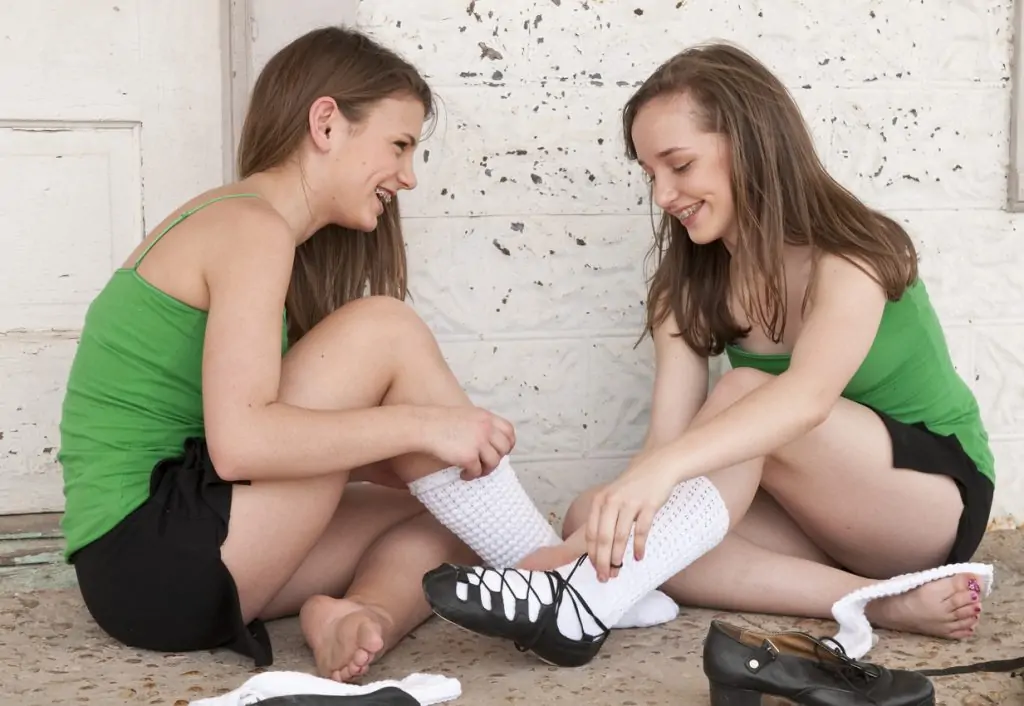
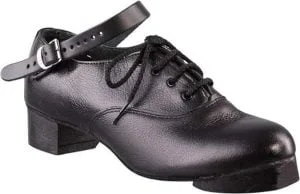
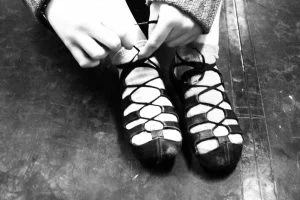
1 thought on “Irish Dance: Essential Beginner Tips”
Pingback: Irish Dance: From Traditional Jigs to Modern Steps